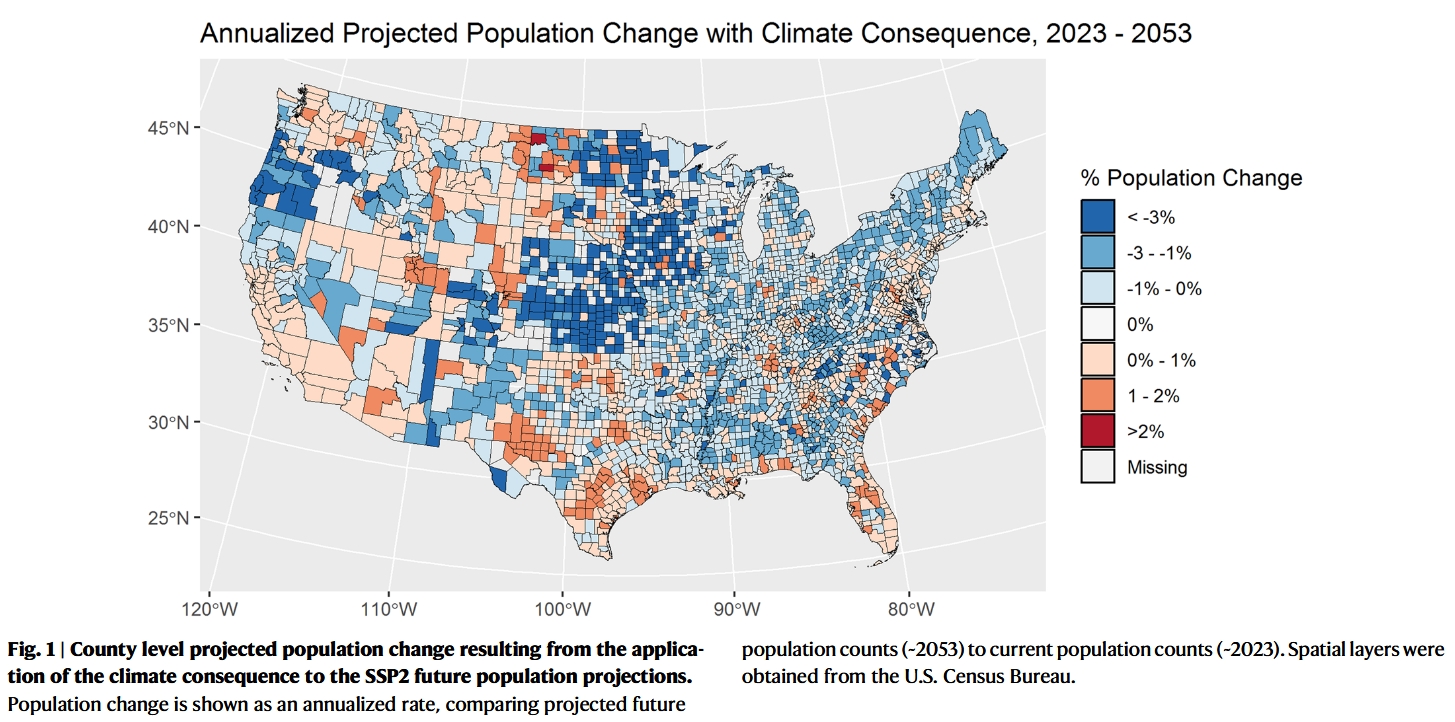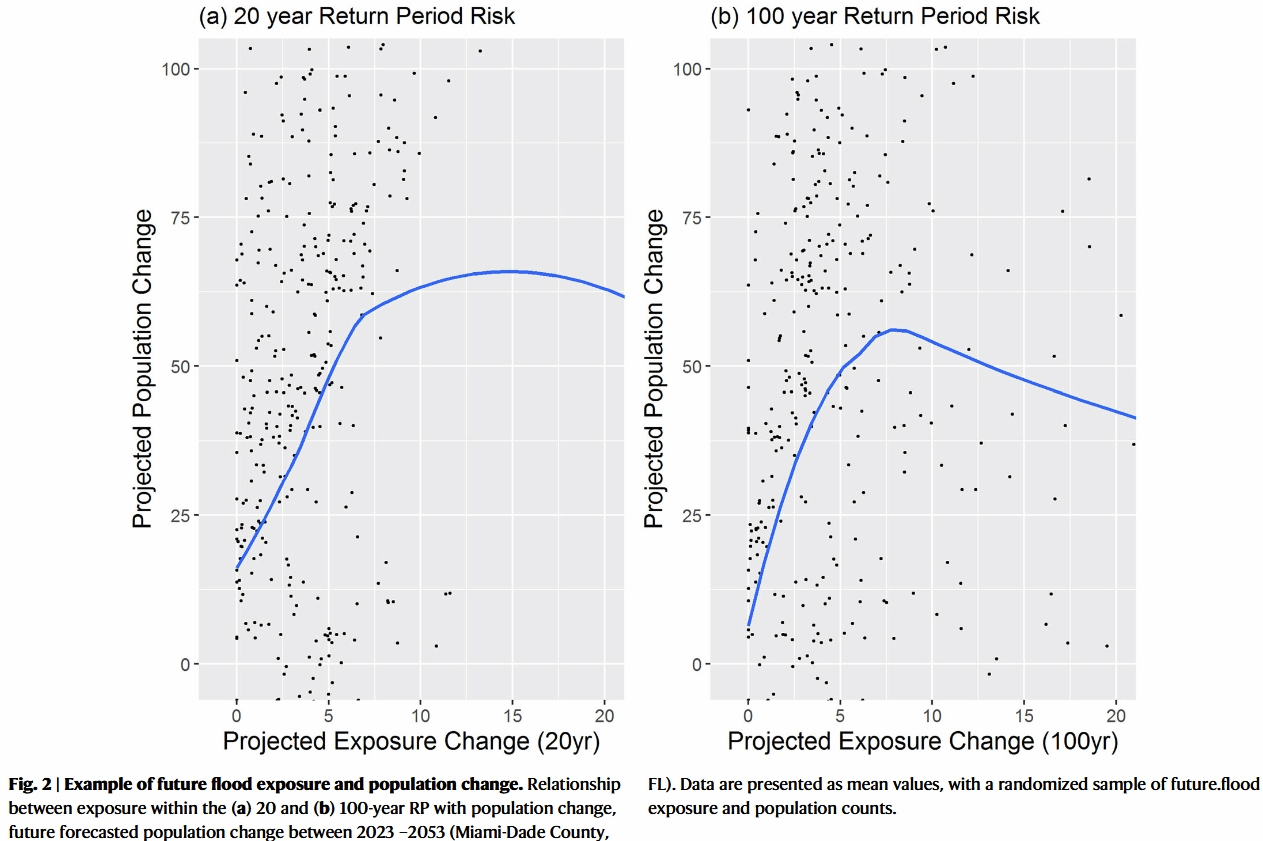文章信息:Shu, E.G., Porter, J.R., Hauer, M.E., Olascoaga, S.S., Gourevitch, J., Wilson, B., Pope, M., Melecio-Vazquez, D. & Kearns, E. (2023). Integrating climate change induced flood risk into future population projections. Nature Communications, 14, 7870. https://doi.org/10.1038/s41467-023-43493-8
整理人:闫甲祺,2024级硕士研究生
整理时间:2024年11月23日
Abstract: Flood exposure has been linked to shifts in population sizes and composition. Traditionally, these changes have been observed at a local level providing insight to local dynamics but not general trends, or at a coarse resolution that does not capture localized shifts. Using historic flood data between 2000-2023 across the Contiguous United States (CONUS), we identify the relationships between flood exposure and population change. We demonstrate that observed declines in population are statistically associated with higher levels of historic flood exposure, which may be subsequently coupled with future population projections. Several locations have already begun to see population responses to observed flood exposure and are forecasted to have decreased future growth rates as a result. Finally, we find that exposure to high frequency flooding (5 and 20-year return periods) results in 2-7% lower growth rates than baseline projections. This is exacerbated in areas with relatively high exposure to frequent flooding where growth is expected to decline over the next 30 years.
摘要:洪水暴露与人口规模和构成的变化有关。传统上,这些变化是在局部层面观察的,提供了对局部动态的洞察,但不是总体趋势,或者以不捕捉局部变化的粗略分辨率观察。利用 2000 年至 2023 年美国本土 (CONUS) 的历史洪水数据,我们确定了洪水暴露与人口变化之间的关系。我们证明,观察到的人口下降在统计上与历史洪水暴露水平较高有关,这可能随后与未来的人口预测相结合。一些地方已经开始看到人口对观察到的洪水的反应,预计未来的增长率会因此下降。最后,我们发现高频洪水(5 年和 20 年重现期)导致增长率比基线预测低 2-7%。在经常发生洪水的地区,这种情况会更加严重,预计未来 30 年的增长将下降。
1.研究背景:
2.研究意义:
3.研究方法:
历史洪水数据:使用2000-2023年间美国本土48州(CONUS)的历史洪水数据,识别洪水暴露与人口变化之间的关系。
人口预测模型:结合历史洪水暴露数据和未来人口预测,使用倾向得分匹配和统计建模过程,隔离洪水与人口关系的历史数据。
气候调整洪水风险信息:使用First Street Foundation Flood Model(FSF-FM)估计洪水暴露,并将其纳入未来30年的人口预测中。
4.主要结论:
洪水暴露与人口下降的关联:研究发现,观察到的人口下降与历史洪水暴露水平较高有统计学上的关联。
洪水风险对人口增长的影响:预计高频率洪水(5年和20年重现期)的地区比基线预测低2-7%的增长率。
地区差异:在洪水暴露较高的地区,未来30年的人口增长预计将下降。
5.研究展望:
气候迁移的复杂性:研究结果表明,气候迁移是一个复杂现象,需要在更细的尺度上考虑洪水风险对人口变化的影响。
未来研究的不确定性:研究指出,未来适应措施可能会减轻或加剧洪水风险对人口变化的影响,这为未来研究提供了不确定性和机会。
高分辨率数据的重要性:高分辨率数据对于更好地理解美国内部气候迁移的潜力至关重要,有助于社区为气候变化的影响做好准备,并为决策提供见解。
6.研究主要图表:

01将气候后果应用于 SSP2 未来人口预测而导致的县级预测人口变化

02未来洪水暴露和人口变化的示例

03将气候后果应用于 SSP2 未来人口预测而导致的预计人口变化(佛罗里达州迈阿密戴德)
原文链接:https://www.nature.com/articles/s41467-023-43493-8
原文转引:https://mp.weixin.qq.com/s/HRMZQK0_qDEM63naxiOb4g